By Dr. Rama V. Bennur
Kanakanahalli Vasudevacharya, popularly known as Mysore Vasudevacharya, is considered as ‘Abhinava Tyagaraja’. His contribution to Karnatak music as a composer is very valuable.
An accomplished musician and a Sanskrit scholar, Vasudevachar’s compositions reflect his both the qualities . His house in Mysuru, which was in a dilapidated condition is now buzzing with musical activities. Thanks to the brothers, Srinivas and Yadupathi Putty. Almost two or three concerts in a month happen there. Local and artistes from outside consider it as a blessing to sing in Acharya’s house.
Recently, Vid. G.K. Manmohan sang Acharya’s compositions there (7.1.2023). He had only violin for the accompaniment to enhance the musical feeling in the small hall.
Manmohan is one of our very talented singers who was taught music by dedicated teachers like Vidushis H.N. Rajalakshmi, Vasantha Sundar Rajan and Pushpa Shrinivasan. He has also learnt mandolin for 16 years! His deep love for classical music brought him back to India from a lucrative job in California. His rich imaginative rendering laced with awesome datu swara prayogas and enthusiastic spirals are the hallmarks of his singing. He was accompanied by the talented Keshava Mohan on violin. ‘Devi Rame mamava’ (Raga-Vasntha-Adi Tala) was the opening kruti that had a sparkling prelude. Kalpana swaras consisted lightening sancharas of datu swaras. Actually it is a challenge to experiment datu swaras in a vakra raga. But he carried it effortlessly.
A not-so-heard, dignified composition ‘Pranamamyaham Sri Prananatham’ in the raga Ranjani, set to Misra Chapu was literally a musical treat. The magnificent manodharma came alive in both alapana and kalpana swaras. The spirals, birkas and fast sangathis in his rendering, which is usually in madhyama kala makes it lively. ‘Nachaividavakura’ (Natakuranji-Rupaka), ‘Sri Vasudeva Sri Ramana’ (Ramapriya-Khanda chapu), ‘Idi samayamu’(Natakapriya) and ‘Paripahimam’ (Shubhapnthuvarali) were the other compositions he sang. Keshava Mohan gave very good support on violin. Manmohan’s selection of rare krutis was a welcome.
Ganabharathi
Young vocalist of Mysuru, Vidu. M.R. Sudha gave a concert at the Veene Seshanna Bhavan under the aegis of Ganabharathi on the 13th of January 2023. Sudha was honed by the senior musician of Mysuru Vidu. Gowri Kuppuswamy. Sudha was accompanied by Adithi Krishnaprasd on violin, G.S. Ramnujam on mridanga and V.S. Ramesh on morcing.
‘Amboruha’, a Varna in the Raga Ranjani in two speeds gave a good start to the concert (composed by GNB, set to adi tala). After saluting to Lord Ganapathi in ‘GumGanapathe’ (Hamsadhwani-Adi-Muthaiah Bhagavatar) laced by an attractive chitteswara and crisp kalpana swaras, she proceeded to present a short alapa of raga Devagandhari. Papanasam Shivan’s kruti on Saraswathi ‘Sharade veenavaadana visharade’ set to adi tala set the mood to forthcoming treat.
Sudha’s rendering of Raga Sriranjini confirmed her rich manodharma. A perfect approach with all the required embellishments to enhance the raga bhava filled the hall. Young Adithi too was equally good in her bowing. Tyagaraja’s ‘Marubalka (Adi) never ceases to please the listeners. The Kruti was decorated with interesting Kalpana swara by both Sudha and Adithi.
Though the main Raga of the day was Kambodhi, it was Hameerkalyani that turned out to be a testimony to her musical imaginations. Every phrase was pleasing for the pleasure of rasikas. She unfurled all the possibilities of this beautiful raga. Adithi’s handling of Hameerkalyani on violin was equally pleasant with her innovative sangathis. Subbaraya Shastri’s evergreen composition ‘Venkata shaila vihara’ was a perfect choice. She did justice to kambodhi by breathing life to it. The age old phrases came alive in her manodharma. Tyagaraja’s another gem ‘O Rangashayee’ was superb with a neraval at ‘Bhuloka vaikutha idiyani’ followed by an elaborate kalpana swaras. The tani avartha by Ramanujam and Ramesh was filled with engaging and stimulating jathis by both the percussionists. Their support throughout the concert was commendable.
The concert ended with a few Devaranamas like ‘Narayana ninna naamada mahime’, ‘Yadavaraya Brindavanadolu’.
Delightful flute concert by Sameer Rao
Ninaada Griha Sangeet,’ a monthly baithak series, curated by Ranjani Memorial Trust, Udupi, was organised here in Mysuru, as the second in the series, on Jan. 29 at Ninaada, Rishabh Siddhi Apartment, Kergalli, Mysuru.
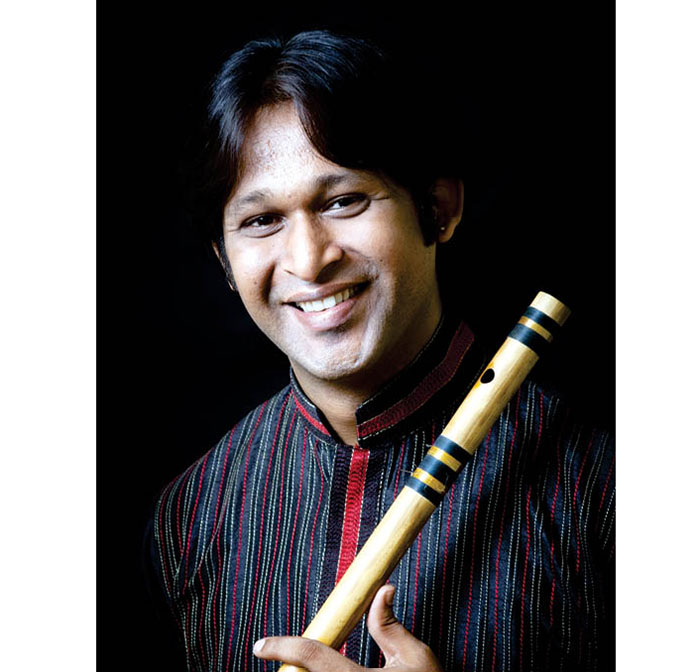
The young and vibrant flautist of Mysuru, Sameer Rao, a disciple of Pt. Hariprasad Chaurasia, presented the delightful flute concert, true to the line of his lineage. A rare raag called Sandhyashree was his choice of the evening. This raga, created by his guru Chaurasia, Sameer Rao delved to layakari in its gat in Matt tal carrying 9 matras with brilliant gaits, after a mellifluous rag alap and jod.
The end piece thihaays were wisely constructed to suit best for the percussive beauties of the tabla artiste Gururaj Adukala from Honnavar. His playing not only soothed the flow of flute but also proved his able saath along the rhythmic patterns of the composition.
Sameer continued the recital further with raag Des. His creativity found no bounds in this most popular melody wherein he kept the audience spell-bound with his free lance manodharma capturing the learned ears too to dissolve in his captivating sways and whirls.
He concluded the concert with a dhun in raag Manj Khamaj. Needless to say that the sound audibility along with best quality acoustics at the small hall of Ninaada, provided a proven success to this evening concert.
While the curator V. Saranga Hebbar welcomed Shrimatidevi proposed a vote of thanks.
Feb. 26 recital
Next ‘Ninaada griha sangeet’ will be on Feb.26 at 6 pm with Bansuri recital by Ravishankar Mishra and Tabla Jugalbandi by Dr. Udayraj Karpur and Master Pradyumna Karpur.



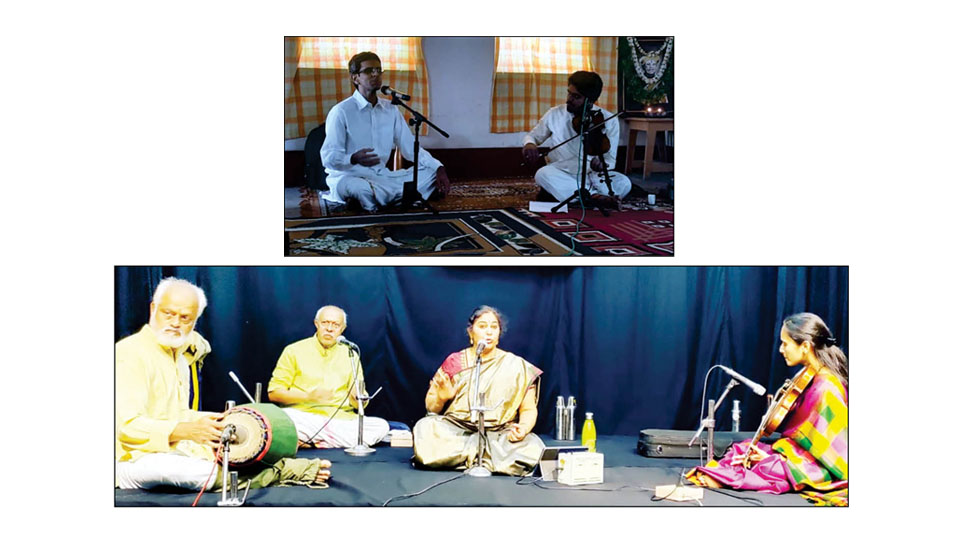

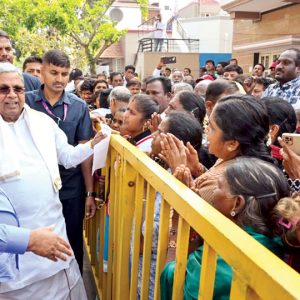
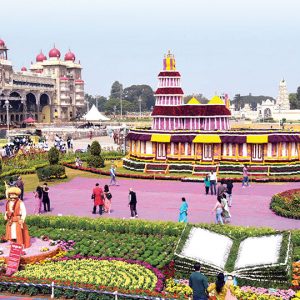
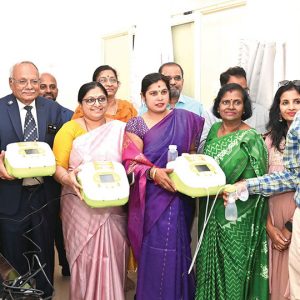
It was said Vasudevacharya’s ancestors were from Satyamangalam in Coimbator district of Tamil Nadu. Hence, he spoke very good Tamil.
His house remained deserted because, he could not earn his livelihood in Mysore, under Jayachamaraja Wadiyar, and hence had to leave to Adyar as Rukmini Arundel invited him to the Kalakshetra there, after the demise of Tiger Varadachar, so he could take the position available.
It was a pity that Nalwadi Wadiyar ignored him in favour of Harikesanallur Muthiah Bagavathar. In fact, Vasudevachar got funds from Mysore Palalce to study music under Patnam Subramaniya Iyer, in Thiruvayyar. But, on his return, the Palace was not much interested in him,, favouring Harikesanallur Muthiah Bagavathar instead.
After Muthiah Bagavathar’s departure to Trivandrum as the Principal of the newly formed Swati Tirunal Music College, Jayacharaja Wadiyar ( JC Wadiyar)invited Vasudevachar for a time , but strangely as normal JC Wadiyar lost interest in him soon .
WhenVasudevachar left for Kalakhestra, Adyar, he vowed never to come back to Mysore, At last, under Rukimi Arundel, he got the recognition he well deserved.
!930s was when Vasudevachar was awarded the Sangeetha Kalanidhi title by the Madras Music Academy: https://en.wikipedia.org/wiki/Sangeetha_Kalanidhi
Mahararjapuram Iyer rendering of Vasudevachar Kriti was not an exception. GNB did it in front of Vasudevacharya at the Academy concern when he sang the Kriti” Vasudevayani” in Kalyani, to which Vasudevaracharya reportedly said he never knew his Kriti could be so exquisitely handled. Vasudevacharya also encouraged Balamurali Krishna to sing his Kriti” Devadi Deva Sri Vasudeva”. Vasudevachar thus enjoyed his stay in Adyar.
Both GNB and Balamuralikrishna did not want their sons to follow them in music. Balamurali’s sons are all doctors, not interested in Carnatic music, so were GNB’s sons.
Vasudevachar did not sell his house, because his relatives were happy to look after it by living there.
His house , which I passed every day in 1950s and 1960s, was well maintained then with relatives living there.
It must have been left unoccupied later and hence its dilapidated condition for a period.
As for some one leaving California and a lucrative job, to come to Karnataka to take up Carnatic music performance as the occupation, I have a comment to make. California is full of IT companies, and the turn over of staff is very brisk. Hence, the IT professionals has vey little free time, as they have work hard to retain their jobs.
There is no need to return to Karnataka for Carnatic music performance,, as there are enough Indians-hundreds of thousand so f them across the US and Europe, many of them from S India, and the places like Cleveland Ohio, has clusters of Indian families who regularly arrange Carnatic performances including the Tyagaraja Aradhana. Hence, never take hearsay as the gospel truth. He must have found working in India-Bangalore gives him steady income and companies which do outsourced work -cheap labour one could say, are not subjected to the same vagaries of market-driven situation in the USA.
It was a pity that the great composer Vasudevachar, born and lived in Mysore for decades did not get the kind of strong patronage from Wadiyars one would have expected of them. The same goes to Mysore Sadashiva Rao, not originally from Mysore, but having blessed by Thyagaraja himself in person. Both Mysore Sadashiva Rao and Mysore Vasudevachar quintessentially carried through the musical heritage of Tyagaraja, the fomer linked to Thyagaraja directly, and the latter of the next generation linking to Tyagaraja through his mentor.
The places-that is homes, in Mysore where Mysore Sadashiva Rao lived were redeveloped and hence lost, but in the case of Mysore Vasudevachar, his house where he lived and composed most his Kritis, which had been immortalised by by the colossuses of Carnatic music in his life time, were left in a dilapidated state for an extended period, after he moved to Adyar Kalakshetra. It was a shame that Jayacharaja Wadiyar did not seem interested to continue the patronage to this great composer, and it was left to Rukmini Arundel to provide it.
I was young when the news of Mysore Vasudevachar’s move to Adyar was met with sadness. Neither Jayacamaraja Wadiyar nor the Mysore government earlier and Karnataka government later did not fit to give him the recognition he deserved for then the living legend
and the support that was needed to keep him at his house in Mysore. Even after his demise in 1961, the Karnataka government failed to declare his house as the heritage structure.
It was a pity that the genius of Mysore Vasudevachar, and the genius of Mysore Chowdaiah was recognised in Tamil Nadu. Fortunately, Mysore Chowdaiah through his involvement of Bidaram Krishnappa Mandira and the Ramanavami Music concerts there, immortalised his stature in Mysore. He was able to encourage young musicians like Veena Chiiti Babu, by inviting him to give his Veena concerts in the Bidaram Krishnappa Mandira. I was fortunate to listen to as part of the audience, Chowdaiah’s introduce Chitti Babu. He acceded to the younger audience request by playing the’Come September’ films theme music in his Veena then.
It was a pity that the great composer Vasudevachar, born and lived in Mysore for decades did not get the kind of strong patronage from Wadiyars one would have expected of them. The same goes to Mysore Sadashiva Rao, not originally from Mysore, but having blessed by Thyagaraja himself in person. Both Mysore Sadashiva Rao and Mysore Vasudevachar quintessentially carried through the musical heritage of Tyagaraja, the fomer linked to Thyagaraja directly, and the latter of the next generation linking to Tyagaraja through his mentor.
The places-that is homes, in Mysore where Mysore Sadashiva Rao lived were redeveloped and hence lost, but in the case of Mysore Vasudevachar, his house where he lived and composed most his Kritis, which had been immortalised by by the colossuses of Carnatic music in his life time, were left in a dilapidated state for an extended period, after he moved to Adyar Kalakshetra. It was a shame that Jayacharaja Wadiyar did not seem interested to continue the patronage to this great composer, and it was left to Rukmini Arundel to provide it.
I was young when the news of Mysore Vasudevachar’s move to Adyar was met with sadness. Neither Jayacamaraja Wadiyar nor the Mysore government earlier and Karnataka government later did not fit to give him the recognition he deserved for then the living legend
and the support that was needed to keep him at his house in Mysore. Even after his demise in 1961, the Karnataka government failed to declare his house as the heritage structure.
It was a pity that the genius of Mysore Vasudevachar, and the genius of Mysore Chowdaiah was recognised in Tamil Nadu. Fortunately, Mysore Chowdaiah through his involvement of Bidaram Krishnappa Mandira and the Ramanavami Music concerts there, immortalised his stature in Mysore. He was able to encourage young musicians like Veena Chiiti Babu, by inviting him to give his Veena concerts in the Bidaram Krishnappa Mandira. I was fortunate to listen to as part of the audience, Chowdaiah’s introduce Chitti Babu. He acceded to the younger audience request by playing the’Come September’ films theme music in his Veena then.